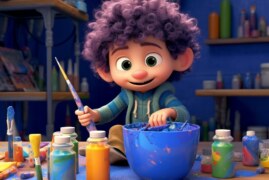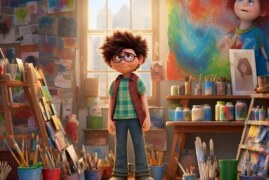Red is a bright, bold and powerful color commonly associated with passion, love, and warmth. In the world of art and design, it’s also a popular color choice to make a statement or evoke emotions in any given project. But, have you ever wondered how to create the color red from scratch? While you may think that it’s as easy as mixing a few colors together, the process of making this fiery hue requires more precision and attention to detail. In this article, we’ll explore the different methods and techniques used to create different shades of red, as well as the science and theory behind color mixing. Whether you’re an artist, designer, or simply curious about the world of colors, this guide will provide you with all the necessary information to master the art of making the color red. So, let’s dive right in!
1. Understanding the Basics of Color Mixing: Red
How To Make The Color Red: Understanding the Basics of Color Mixing
The color red is a primary color in the traditional color wheel system, which means it cannot be made by mixing two other colors together. However, there are different ways to create shades and tints of red by mixing other colors and pigments together. Understanding the different methods of color mixing is essential when it comes to creating a specific shade of red in your artwork or design project.
Primary Color Mixing:
Primary colors are the fundamental colors that cannot be created through any other color mixing combination. The primary colors in the traditional color wheel are red, blue, and yellow. When these colors are mixed together in equal parts, they create secondary colors, such as orange, green, and purple. When red is mixed with blue, it creates purple, and when it is mixed with yellow, it creates orange. However, if you mix all three primary colors together, they will create a neutral color, usually black or brown.
Secondary Color Mixing:
Secondary colors can be created by mixing two primary colors together. When creating different shades of red, adding a small amount of purple or orange to red will create a darker or lighter shade, respectively. For example, adding a small amount of purple to red will create a deeper, burgundy color. Similarly, adding a small amount of orange to red will create a brighter, warmer shade.
Tertiary Color Mixing:
Tertiary colors are created by mixing a primary color with a secondary color. By combining red with different shades of purple or orange, you can create unique tertiary colors of red. Experimenting with different ratios of colors and pigments can help you find the perfect shade of red for your art or design project.
Understanding the basics of color mixing is a crucial step in achieving the perfect shade of red. The key is to experiment with different colors and ratios until you find the perfect balance that creates the exact hue you want.
2. Essential Tools and Materials for Creating Red Pigments
The color red is one of the primary colors in the subtractive color model used for painting and printing. It is created by mixing two secondary colors, magenta and yellow. In order to create rich and vibrant shades of red, you need to have a few essential tools and materials at hand:
- Pigments: To create red pigments, you need to have access to pigments that contain red hues. Some common sources of red pigments include cadmium red, vermilion, and alizarin crimson. These pigments can be purchased in tubes or jars from art supply stores, or they can be made from natural sources.
- Binder: A binder is used to hold the pigments together and help them adhere to the canvas or paper. Common binders used in art include linseed oil, gum arabic, and egg yolk. Each binder has its own unique properties that can affect the final outcome of your artwork.
- Palette: A palette is a surface on which you mix your paints. It can be made of wood, plastic, or glass. When mixing red pigments, it is important to use a clean palette to prevent other colors from contaminating your mixture.
- Paintbrushes: It is important to use high-quality paintbrushes when mixing and applying red paint. Different brush types can create different effects, so it’s essential to select the right brush for your project.
By having these essential tools and materials, you can create gorgeous vibrant shades of red that will enhance your artwork and design projects.
3. Techniques for Mixing Different Shades of Red
How To Make The Color Red:
In creating different shades of red, an artist or designer needs to have a basic knowledge of color mixing. Knowing how to create primary colors, secondary colors, and tertiary colors is essential in creating different shades of red. Mixing red with other primary colors like yellow and blue can create various shades of orange and purple, respectively. Meanwhile, mixing red with tertiary colors like yellow-green, yellow-orange, blue-green, or blue-purple can create a range of tertiary colors.
1. The Formula of Mixing Red with Other Colors
The recipe for making various shades of red depends on the purpose or context of its use. For example, mixing red with white or black can result in a variety of pink or maroon hues, respectively. To create light red or pink, mix a small amount of red with white, and gradually add more red to create darker shades. On the other hand, to create maroon or burgundy, add a small amount of black to red, and gradually increase the black to achieve the desired shade.
2. Experimenting with Texture and Medium
Mixing red with different textures and mediums can also create various shades of red. For example, mixing red with acrylic gel medium can create a thicker and more vibrant shade, while mixing it with water can create a watercolor-like effect. Adding impasto or texture can create a more tactile or three-dimensional quality in the red color, making it more visually appealing.
Knowing how to mix different shades of red can elevate the quality of an artwork or design project. It allows artists and designers to experiment and create unique and personalized colors that match their creative vision.
4. Exploring the Psychology of Red in Art and Design
Red is an attention-grabbing color that evokes powerful emotions and associations. As an artist or designer, it’s important to understand how to use this color effectively to convey the desired message or mood.
The Meanings and Symbolism of Red
Red is often associated with passion, love, energy, and courage, but it can also represent danger, anger, and aggression. In art and design, the meaning of red can vary depending on its context and the culture or audience it’s being presented to. For example, in Western cultures, red is often associated with love and Christmas, while in Chinese culture, it’s a symbol of good luck and prosperity.
Using Red in Art and Design
When using red, it’s important to consider the tone and intensity you want to convey. Lighter shades of red can feel more romantic or playful, while darker shades can feel more intense and passionate. Red can also be used as an accent or focal point in a piece to draw attention and create contrast. It’s important to balance the use of red with other colors to create a cohesive composition. Additionally, consider the medium you’re working with – red may appear differently on a computer screen compared to a painting or fabric.
Overall, understanding the psychology of red can help artists and designers effectively use this powerful color to create a specific mood or message in their work.
5. Tips for Using Red Effectively in Your Artwork or Design Project
When it comes to using the color red in your artwork or design project, there are a few tips to keep in mind to help you use the color effectively. Here are some guidelines to consider:
1. Use Red as an Accent Color
Red is a bold and attention-grabbing color, so using it sparingly as an accent can have a powerful impact. Consider using red to highlight important elements in your design, such as headlines, call-to-actions, or key graphics. This will draw the viewer’s eye to these elements and create a sense of hierarchy in your design.
2. Pair Red with Complementary Colors
Red is a primary color, which means it pairs well with its complementary color- green. Using these colors together creates a strong visual contrast that can be visually appealing. Combining red with other complementary colors like blue or purple can also create interesting and dynamic color schemes.
3. Consider the Context and Mood
The context and the mood of your design project should also be considered when using the color red. For example, red can evoke feelings of passion, romance, love, or anger, which makes it ideal for designs with a bold or confident tone. However, for more calming or serene designs, using red may not be appropriate. Be mindful of the overall message you want to convey and what emotions you want to evoke with your design.
By keeping these tips in mind, you can use the color red effectively in your artwork or design project to create bold and impactful visual elements. Remember, the key is to be intentional and purposeful in your use of color to best convey your message and achieve your desired outcome.
People Also Ask
What primary colors make red?
Red can be made by mixing the primary colors blue and yellow, or by mixing magenta and yellow.
How do you make red with food coloring?
To make red with food coloring, mix equal parts of red and blue food coloring. If the color appears too dark, add small amounts of yellow food coloring to lighten it.
What colors make bright red?
To make a bright red color, mix equal parts of magenta and yellow paint or dye. Adjust the mix as needed to achieve the desired shade of red.
Can you make red with just primary colors?
Yes, red can be made with just primary colors. Mix blue and yellow together, or magenta and yellow together to create a red color.
How do you make red frosting?
To make red frosting, use red food coloring and mix it with white frosting until the desired shade is achieved. If the color appears too dark, add more white frosting to lighten it.
Conclusion
Red is a primary color that can be created by mixing other colors such as blue and yellow, or magenta and yellow. By adjusting the amounts of these colors, different shades of red can be achieved. Whether it’s for art, decorating, or baking, knowing how to make red is a useful skill to have.



